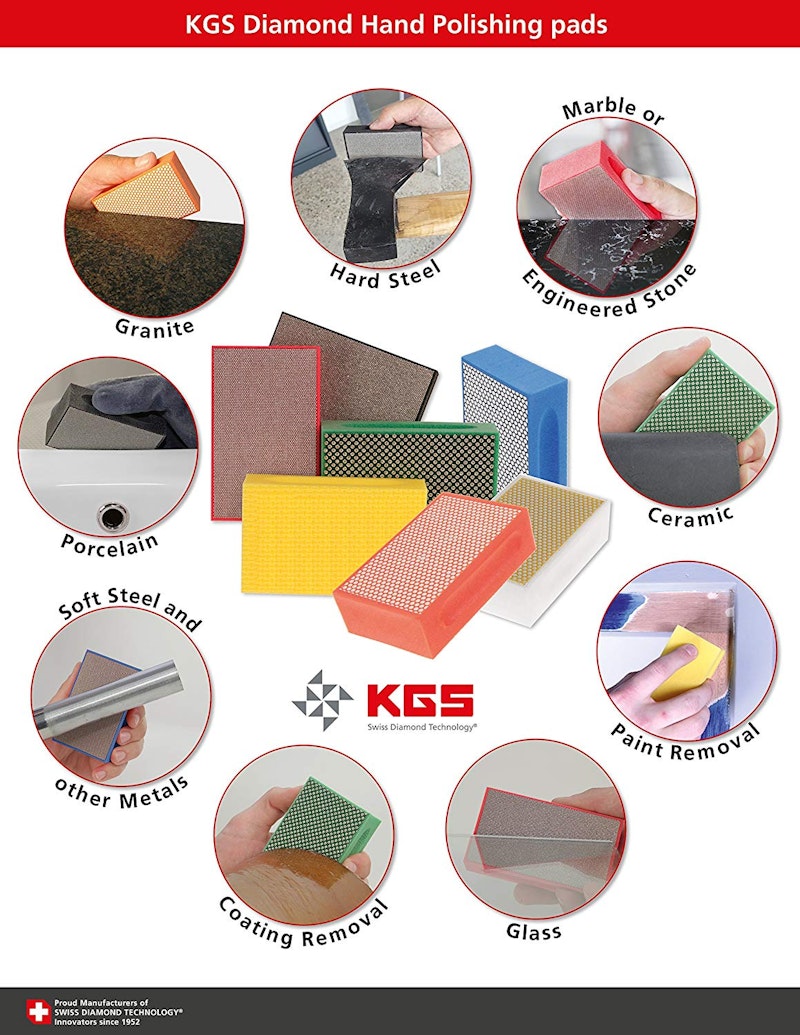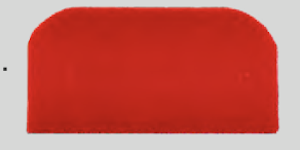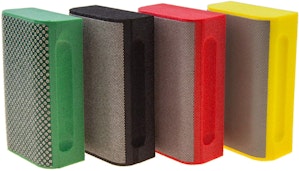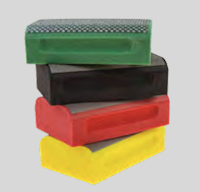Diamond Hand Polishing Pads
Our electroplated diamond hand sanding pads can be for hand grinding and polishing on hard to reach surfaces, corners or edges.
Ideal for use on glass, natural or engineered stone, tile, ceramic, mosaics, pottery, granite, marble, Dekton, porcelain, alumina, concrete and composites.
Also ideal for deburring, tool sharpening and defect removal.
Our pads are well suited for rough grinding or fine polishing in hard to reach spaces, edges, corners etc.
Can be used dry, or a little water on the grinding surface improves the process.
The range we import are long lasting and out perform the cheap pads available online.
Manufactured by KGS, we sell these pads to mining companies, artists, concrete workers and DIY people all over Australia.
KGS only manufacture premium products, and these pads outperform the cheap Chinese pads purchased off the internet.
Note: The glue of the diamond hand pads could tolerate temperature up to 95 degrees Celsius. The glue deteriorates easily when it is kept at a high temperature for a long time. Store away from heat.
Flexis diamond sheet handpads:
Diamond sheet with thin flexible foam back pads.
Flexible, for hard to reach locations
For wet and dry use.
63.5mm x 63.5mm
Download manufacturer's info here Click Here
|
|
|
The Swiflex BC by KGS are hand pads with open structure and a continuous wave pattern of diamonds.
These pads are very hard, so good for flat surfaces and straight grinding.
This also allows a high stock removal rate, with very little clogging.
Excellent for glass, ceramic and porcelain.
Swiss Diamond Technology®
Measure 90 x 55 x 30mm.
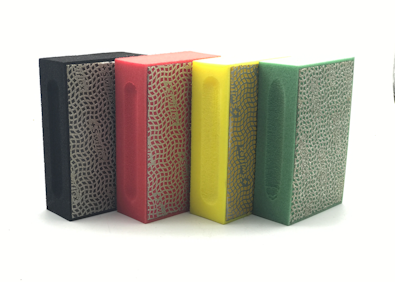
|
|
KGS's Flexis Hand Pads are professional standard pads with dot pattern.
These pads have a strong yet slightly flexible backing (you could not squeeze one in your hand).
Their dot pattern makes them ideal on curved surfaces.
They have a high temperature resistance due to superior heat dissipation.
Free cutting and long lasting.
Swiss Diamond Technology®
Measure 90 x 55 x 30mm
Square edge
To remove small faults or bevel edges on glass, starting with #60 grit, then moving to # 400 grit, and finishing with #1500 grit is a suggestion.
Can be used dry, but to obtain a more polished finish use with water.
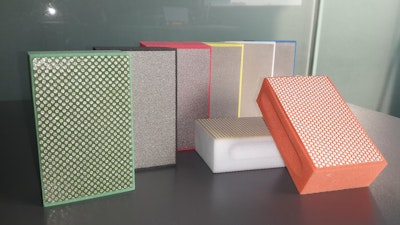
|
|
Curved Flexis Hand pads - in stock in Bibra Lake.
Suitable for various materials and applications.
Ideal for quickly removing small scratches or damages.
Thanks to the diamond, the abrasives have an extremely long service life compared to conventional sandpaper.
The rounded corners make the KGS Flexis curved handpads the solution for sanding and polishing roundings and deepenings.
Ideal for polishing work where a high degree of precision is required.
|
|
Benefits
|
See the Swiflex BC pads in action here:
Which grit to use?
The lower the number, the coarser the grit, and the more material it will remove.
#60 grit is the lowest, and most aggressive pad.
The higher the number, the finer the grit, and less material will be removed, and more polishing will be achieved.
#3000 grit is the lowest, and least aggressive pad that polishes the most.
You will need to select the grit that removes any uneven surfaces and scratches.
Double the grit size with each stage, gradually breaking down the surface irregularities until the surface is sufficiently smooth. Stop at the grit that offers the polish you want.
Trial and error with a few different pads will help you achieve the finish you need.
Tip:
Many users find the Swiflex pads (#60 - #400 grits) offer value for money.
For grits above #800, use the Flexis pads.
Note - When workers cut, crush, drill, polish, saw or grind products that contain silica, particles are created, which are one-hundredth of the size of a grain of sand. These can get stuck deep in the lungs. Ensure precautions to limit exposure to dust are in place.
Use a half face respirator or a PAPR (Powered air purifying respirator).
See the WA government's info on silica dust here.
Prices correct as of 1/1/25 but subject to change.
All prices are each, and include GST. Postage extra.
Up to ten pads can fit in a small airbag.
See our Contact Us page for Australia wide regular and express postage prices.
Tips on removing small stains on concrete counter tops:
Polishing the stain out too aggressively will change the appearance in that area. Can you try your treatment first in a inconspicuous area?
Wet the surface and begin polishing lightly with the a high grit pad, like a #1500.
Try a #800 grit if the stain is not being removed. There's a danger that grinding too aggressively with the #800 grit pad could change the look of the surface slightly.
Keep polishing until the water gets cloudy.
Sponge it off to see how the stain looks regularly.
If the stain is removed, dry and apply sealer as per manufacturers instructions.
If you require a higher shine, go over the stain again with the #1500 grit and #3000 grit pads.
Let the surface dry then apply sealer as per manufacturers instructions.
Tips on fixing scratches on porcelain tiles:
Polished porcelain tiles may have a glossy, polished glaze, ie they are not uniform all the way through like granite, marble etc. Other tiles may have a lacquer finish. Rubbing in one spot (either by hand or with a grinder) may leave an area of hazy finish, ie not the usual gloss finish as the rest of the tile.
If the scratches are minor, try baking soda, toothpaste, brass polish or Barkeepers Friend to manually remove porcelain scratches. Thoroughly clean the scratch, then apply over the length of the scratch. Buff the scratches with a soft, damp cloth. After it is thoroughly clean and dry, some people have success sealing the tile by applying car wax to bring up the gloss again. This manual method needs a lot of effort (elbow grease!).
If you wanted to try our pads, we suggest you start with a #3000 grit.
If that did not remove the scratches, try a #1500 grit, finishing off with the #3000 grit.
You may need to go as low as #800 grit.
Always try first in a inconspicuous spot.
Disclaimer: the information on this website is provided in good faith and believed to be reliable and accurate at this time. However, the information is provided on the basis that the reader will be solely responsible for assessing the information and its veracity and usefulness. UDT shall in no way be liable, in negligence or howsoever, for any loss sustained or incurred by anyone relying on the information, even if such information is or turns out to be wrong, incomplete, out-of-date or misleading.
